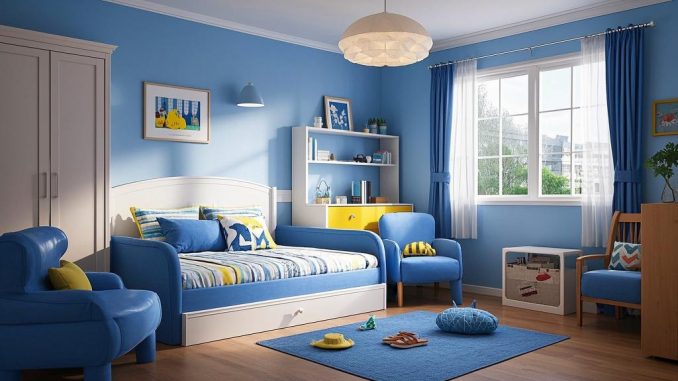
In traditional Chinese culture, Feng Shui has long been regarded as a way to influence people’s lives. When it comes to children, many parents believe that Feng Shui layout can play a significant role in their learning and growth.
I. General Introduction to Feng Shui and Children
Feng Shui is based on the concept of the harmony between humans and the environment. In the context of children, a suitable Feng Shui layout is thought to promote positive development. Children are more sensitive to their environment, so the home environment layout, according to Feng Shui principles, is highly relevant.
II. Specific Feng Shui Factors Related to Children’s Learning and Growth
1.Room Shape and Location

- As mentioned in the materials, irregular – shaped rooms, especially triangular ones, may adversely affect children’s character development. A spacious and regularly – shaped room is more conducive to cultivating an optimistic and lively personality. The ideal children’s room should be able to receive the morning sun earliest. East – facing or southeast – facing rooms are preferred. The east corresponds to the Zhen Gua, symbolizing the eldest son, and the southeast corresponds to the Xun Gua, symbolizing the eldest daughter. Parents can choose the room’s location based on the child’s gender.
2.Bed Placement

- The head of the bed should be oriented properly. East and southeast directions are better as they belong to the element of wood, which is beneficial for growth and learning. Bed head facing south may make the child irritable and moody, while facing southwest may make the child introverted and reluctant to express themselves.The northwest direction represents authority and stability, and is more suitable for adults to live. If the child lives in the northwest room for a long time, it may lead to their early puberty and prolong the rebellious period. Northeast direction may cause children to be careless and lack concentration. Also, the bed should not be placed under a beam as it can bring a sense of oppression, affecting sleep quality and learning performance.
3.Study Environment
- Bookcase placement: The desk should not face the toilet or be back to the bathroom, nor should it be back to the door or face the straight – shot outside. It is advisable to place it at the Wenchang position. If the Wenchang position is pressed (by a beam), dirty (near a toilet), or missing, it will cause the learner’s fortune to decline, and thinking will be unclear.

- Lighting: Adequate lighting is crucial. Natural light is the best as it can bring positive energy. In rooms with insufficient natural light, artificial lighting should be used to avoid a gloomy atmosphere that can negatively impact children’s learning.
- Color: The color of the children’s room should be bright to create a lively atmosphere. Walls should be light – colored and simple to avoid distracting children. Dark or complicated colors in the study color is still a little brighter will be better, you can choose a light color wallpaper, so it is very beneficial to learning, if you choose dark wallpaper it will easily cause a negative impact on the child’s psychology, leading to children’s depression, depression, and even very young depression, seriously affecting learning, but also conducive to the healthy development of children. walls can lead to negative psychological effects on children.
- Decorations: Avoid placing strange – shaped or inauspicious decorations in children’s rooms. For example, placing animal specimens or pictures of fierce animals may affect their physical and mental health, causing instability of emotions and lack of concentration.
4.Home Environment Outside the Room
- The overall living environment also matters. If the residential area has a good environment with more people living in it, there will be more yang energy, which is beneficial for children’s academic performance. On the contrary, a poor – quality environment with few residents may have a negative impact.

- The geomantic shape of the house foundation is also important. If the foundation is uneven, it may affect the child’s academic fortune.
5.Other details that affect the Feng Shui of children.
- Mirror: Mirrors in the bedroom or study can disperse the child’s spiritual energy, making them less intelligent and having a lower memory function.
- ** Electrical appliances**: Too many electronic devices in children’s rooms, such as computers, game consoles, and mobile phones, can make children playful and unwilling to learn. In addition, the radiation from these electronic products may also have a negative impact on the brain.
- Toy placement: Toys should not be placed randomly in areas where children study. Strange – shaped or vulgar – themed toys should not be placed in bedrooms as they may affect children’s sleep quality and lead to nightmares, panic, and lack of concentration.
III. The Scientific Perspective
While Feng Shui has a long – standing cultural influence, from a scientific point of view, some of its claims are difficult to prove. For example, there is no scientific evidence that the shape of a room directly affects a child’s character or academic performance. However, some principles in Feng Shui, such as the importance of good lighting and a clean environment, have scientific basis. Good lighting can protect children’s eyesight and improve their learning efficiency, while a clean environment can reduce the spread of germs and create a more comfortable living and learning atmosphere.
In conclusion, although Feng Shui layout has a cultural significance in relation to children’s learning and growth, we should view it with a scientific attitude. Parents can consider Feng Shui – inspired ideas while also focusing on creating a healthy, comfortable, and educational environment for their children through modern scientific knowledge and educational methods.

Leave a Reply